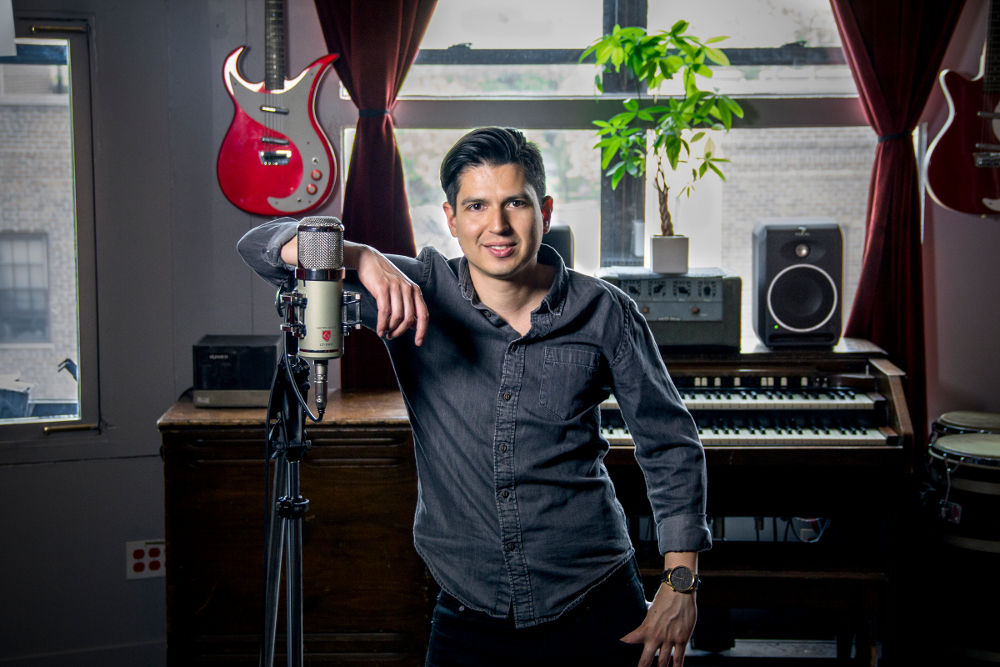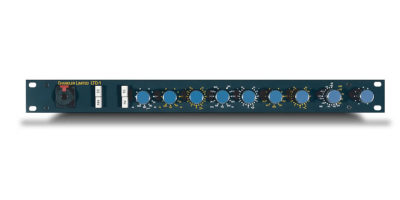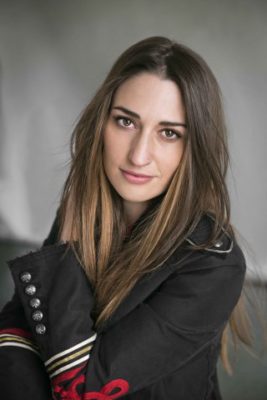Tracking Best Practices: Recording Vocals for Ingrid Michaelson and Sara Barielles
What’s the difference between a personal studio and a commercial recording facility?
While both may be capable of creating a hit single, the engineering expertise and equipment choices are two of the key differentiators at a studio for hire. Both attributes were fully on display during the recording sessions for Ingrid Michaelson’s new single “Miss America” featuring Sara Bareilles, which took place recently at the East Village’s Flux Studios.
As you’ll see, Flux’s chief engineer, Daniel Sanint, had to be fully on point to optimally capture the beautiful vocal tracks laid down by Michaelson and Bareilles in separate sessions. Sanint’s familiarity with multiple microphones, setup expertise, and even studio psychology skills all proved essential for satisfying his client.
Don’t miss this “Tracking Best Practices” from Sanint, who rose from starting as an intern at Flux Studios in 2009 all the way to Chief Engineer and studio manager, building up the discography that includes David Crosby, Moby, James Bay, Andre 3000, Robert Glasper, Brasstracks, Rubén Blades, and many more. Recording star artists means being prepared to perform under pressure – Sanint will show you how.
Artist Names: Sara Bareilles, Ingrid Michelson
Project: Ingrid Michelson’s song “Miss America” on her new EP titled “Alter Egos”

Tracking Location: Flux Studios in the Dangerous room.
Engineer: Daniel Sanint
Past History: I’ve never worked with either of the artists before. However I have worked with the producer before, Chris Kuffner. We collaborated on a couple of projects for A Great Big World a couple of years ago and we always kept in touch, running into each other at gigs and such.
He called me one day and mentioned he wanted to record Ingrid and Sara for Ingrid’s new EP. We had a brief discussion before the session regarding setup, specifically for Ingrid’s vocal mic. Chris has a U47 clone he has used for her in the past so he wanted to have our U47 up for Ingrid’s vocals. I decided I would have an option ready so I put up the Lauten Audio Eden (LT-386 Multi-voicing vacuum tube large diaphragm condenser) mic.
I listened to Sara’s and Ingrid’s previous records to get a sense of the vocal tones and particularities. I’ve listened to them several times at shows and on their records but I didn’t pay too much attention before. This time I definitely focused my listening on their vocal tones, particularly listening for tonal characteristics. Both singers have very rich and full-bodied voices so I felt right away that the Eden was going to be a good option to capture their tones.
Style Smarts: The most challenging aspect about working with Sara was that I knew she didn’t have a lot of time to spend in the studio. She is the type of artist that is ready to record before she even steps into the facility. So there was a sense of urgency for me to get a great capture starting on take one while getting levels.
Typically with these sessions I’ll hit record even for the takes that I’m getting levels because you never know when the best take is going to happen, and that is what it’s all about. So I knew that as soon as Sara entered the recording room I had to have a great sounding chain, that’s why I chose the Eden. I know that I will have to do minimal EQing and compressing for her vocal to sound accurate.
Tracking It! When tracking vocals in the Dangerous room at Flux Studios I always setup a shell with goboes to deaden the sound a bit. I create a sort of shell big enough so that the artist has space to move and walk in and out and have a small table for their tea and water.
There is a fine line between getting a great tone and making sure the artist is comfortable. I’ve never gotten better takes by going overboard with deadening the environment, it makes it too unnatural — that sense of space around a vocal is super important and it starts from the very beginning.
The Eden selection was based on my previous experiences with this mic. The first time I tried it on a female vocal I setup my typical chain, popped in the EQ and stared at it for about 30 seconds until I realized it needed no EQ at all! Not even opening the high end which is typically something I do whenever I track vocals. So I knew right off the bat that the mic was going to get me very close with where I felt comfortable, especially since I had never tracked her before. The high-end extension and the great detail of the Eden made it perfect for the soft intimate vocals we wanted to capture for this song.
I ran the Eden through my typical vocal tracking chain which is a Chandler LTD-1 pre through a Teletronix LA-2A. The setting on the Eden mic was cardiod polar pattern, no roll off and the neutral setting.
In the LTD-1 I engaged the EQ and had the hi pass filter at 50Hz. If I add or take away in the EQ stage it will never be more than one or two steps, if I have to do more than that I know it’s the wrong mic and I’ll swap it out.
For compression I’ll typically do 3 to 5 dB’s, tops, of compression assuming it’s not a belting take. There is nothing more frustrating as a mix engineer than receiving over-compressed sounds. For the LA-2A the biggest thing is getting the gain staging right: I typically find myself toggling between the input and output metering several times, because the output of that compressor is so hot you can distort very easily and for a smooth vocal like this one that would have been a disaster. Once I get that right I’ll dial in the compression and tweak the output again.
For this step I find communicating with the artist is crucial. I ask them to give me the loudest they are going to be and then give myself PLENTY of headroom to allow for them to go louder as they always do once they are in full takes mode. I’d rather starve the compressor on the input and output than risk ruining a take because the artist got louder.

Ingrid Michaelson’s duet with Sara Bareilles, “Miss America” was recorded at Flux Studios in the East Village.
That being said, as with any piece of analog gear there is that sweet-spot that you are always trying to hit to get the right tone. Sometimes I’ll risk a bit of saturation on the loud parts to add more color or body during the really soft parts. With singers like Sara and Ingrid this is not usually the case, their microphone technique is flawless, they know when and how much to back off the mic without changing the response of the gear.
Control Room: We recorded to Pro Tools 12, I believe it was 24 bit 88.2KHz (but I don’t have the files to be sure of that unfortunately).
After tracking Sara we moved on to Ingrid’s vocals, For Ingrid I had the Neumann U 47 as a request of the producer Chris Kuffner — he has a U 47 clone he has used in the past with Ingrid and he felt comfortable with it.
So I set up the same vocal chain, LTD-1 through LA-2A and I start to fiddle with the EQ, in particular I remember trying to match the high end we got for Sara by boosting 16 kHz one step. Then I tried lowering that boost to 12 kHz, then went back to 16 kHz. Then I was fiddling with the presence and she did maybe a full take and I still hadn’t gotten to setting the compressor. So I asked for another take and worked the compressor and then tweaked the EQ again.
At this point you typically notice the artists and the producers getting a bit anxious so I moved on and sat on the chair and said “OK, I’m ready.” In this song Ingrid starts with the first verse and then for the chorus both Ingrid and Sara sing at the same time, and then after that they will double phrases here and there. Once we started the first “real take” for Ingrid and got to the chorus I noticed Ingrid’s vocal felt behind and I was struggling to match Sara with just the levels.
Then Sara’s verse came in and that’s when I realized I had to change Ingrid’s setup — Sara’s vocal was so much bigger and present. After we finished that take Ingrid and Chris were talking about her take (which was a very good take already) and discussing things they wanted to do a bit different or better etc. Then I chimed in and said I wanted to listen back to a couple things before moving on to a second take. I explained what I was hearing to Chris and after listening back he said he felt the same thing. So I explained to Ingrid, and went in and swapped the U 47 for the Eden with the same vocal chain, and the difference was immediate. We got one take to get levels and EQ right, and then we started doing takes.
Extra Extra: Don’t be afraid to stop a session and say “Hey, this is not working properly, I want to try something else.” Even on high pressure situations. It might make people uncomfortable at first but it shows that you have confidence in your skills, and that comes with experience. It’s way better to delay a session by 10 minutes than to get that call the next day from the client saying they aren’t happy with the sound.
— Daniel Sanint, Chief Engineer at Flux Studios
Please note: When you buy products through links on this page, we may earn an affiliate commission.










Matt Verzola
July 20, 2017 at 9:18 pm (8 years ago)informative! thanks!
Justf Savvy
August 1, 2017 at 3:46 am (8 years ago)Hi team , keep up the good work_ Although here a $ 2500 microphone is being used , which many may not relate to.
Not one of your best articles but you guys have been writing some of the best ones.